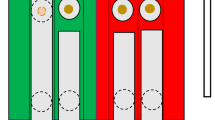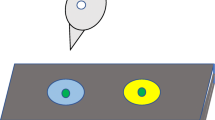Abstract
Three experiments examined the effects of reward magnitude on key pecking and eating by pigeons in a closed economy. In Experiment 1, one deprived pigeon and two nondeprived pigeons key pecked on increasingly higher fixed ratios to earn access to food for the remainder of the session. In Experiments 2 and 3, deprived pigeons working in a closed economy key pecked on either six fixed-ratio or two variable-interval schedules to earn access to one of three short durations of feeding. All pigeons initially key pecked more frequently as the ratio (or interval) size increased or reward magnitude decreased. In Experiments 1 and 2, the point of maximum key pecking varied directly with magnitude of reward and occurred at similar prices (number of key pecks per gram of food eaten). Key pecking on interval schedules also varied inversely with reward magnitude; however, maximum key pecking was sustained over a wider range of prices. The implications of these results for economic models and regulatory models of learned performance and the concept of ratio strain in a closed economy are briefly discussed.
Similar content being viewed by others
References
CATANIA, A. C. (1963). Concurrent performances: A baseline for the study of reinforcement magnitude. Journal of the Experimental Analysis of Behavior, 6, 299–300.
COLLIER, G., HIRSCH, E., & KANAREK, R. (1977). The operant revisited. In W. K. Honig & J. E. R. Staddon (Eds.), Handbook of operant behavior. Englewood Cliffs, NJ: Prentice-Hall.
COLLIER, G. H., & ROVEE-COLLIER, C. K. (1981). A comparative analysis of optimal foraging behavior: Laboratory simulations. In A. C. Kamil & T. D. Sargent (Eds.)., Foraging behavior: Ecological, ethological, and psychological approaches. New York: Garland.
FERNIE, R. W. (1971). A device for measuring food-magazine behavior in the pigeon. Journal of the Experimental Analysis of Behavior, 16, 409–410.
FERSTER, C. B., & SKINNER, B. F. (1957). Schedules of reinforcement. New York: Appleton-Century-Crofts.
HANSON, S. J., & TIMBERLAKE, W. (1983). Regulation during challenge: A general model of learned performance under schedule constraint. Psychological Review, 90, 261–282.
HODOS, W., & KALMAN, G. (1963). Effects of increment size and reinforcer volume on progressive ratio performance. Journal of the Experimental Analysis of Behavior, 6, 387–392.
HOGAN, J. A., & ROPER, T. J. (1978). A comparison of the properties of different reinforcers. In J. S. Rosenblatt, R. A. Hinde, C. Beer, & M.-C. Busnel (Eds.), Advances in the study of behavior (Vol. 8). New York: Academic Press.
HURSH, S. R. (1978). The economics of daily consumption controlling food- and water-reinforced responding. Journal of the Experimental Analysis of Behavior, 29, 475–491.
HURSH, S. R. (1980). Economic concepts for the analysis of behavior. Journal of the Experimental Analysis of Behavior, 34, 219–238.
JENKINS, W. O., & CLAYTON, F. L. (1949). Rate of responding and amount of reinforcement. Journal of Comparative and Physiological Psychology, 42, 174–181.
KEESEY, R. E., & KLING, J. W. (1961). Amount of reinforcement and free-operant responding. Journal of the Experimental Analysis of Behavior, 4, 125–132.
KREBS, J. R. (1978). Optimal foraging: Decision rules for predators. In J. R. Krebs & N. B. Davies (Eds.), Behavioural ecology: An evolutionary approach. Sunderland, MA: Sinauer.
LOGAN, F. A. (1960). Incentive: How the conditions of reinforcement affect the performance of rats. New Haven, CT: Yale University.
LOGAN, F. A. (1964). The free behavior situation. In D. Levine (Ed.), Nebraska Symposium of Motivation (Vol. 12). Lincoln, NE: University of Nebraska Press.
LUCAS, G. A. (1981). Some effects of reinforcer availability on the pigeon’s responding in 24-hour sessions. Animal Learning & Behavior, 9, 411–424.
MORAN, G. (1975). Severe food deprivation: Some thoughts regarding its exclusive use. Psycholog-ical Bulletin, 82, 543–557.
POWELL, R. W. (1969). The effect of reinforcement magnitude upon responding under fixed-ratio schedules. Journal of the Experimental Analysis of Behavior, 12, 605–608.
REESE, T. W., & HOGENSON, M. J. (1962). Food satiation in the pigeon. Journal of the Experi-mental Analysis of Behavior, 5, 239–245.
SIDMAN, M., & STEBBINS, W. C. (1954). Satiation effects under fixed-ratio schedules of rein-forcement. Journal of Comparative and Physiological Psychology, 47, 114–116.
SKINNER, B. F. (1938). The behavior of organisms. New York: Appleton-Century.
SKINNER, B. F. (1953). Science and human behavior. New York: Macmillan.
STADDON, J. E. R. (1979). Operant behavior as adaptation to constraint. Journal of Experimental Psychology: General, 108, 46–87.
TIMBERLAKE, W. (1977). The application of the matching law to simple ratio schedules. Journal of the Experimental Analysis of Behavior, 25, 215–217.
TIMBERLAKE, W. (1980). A molar equilibrium theory of learned performance. In G. H. Bower (Ed.), The psychology of learning and motivation (Vol. 14). New York: Academic Press.
Author information
Authors and Affiliations
Additional information
This research was supported in part by National Institute of Mental Health Grant No. Mh-19300 to Eliot Hearst and Nsf Grant No. Bns 79-15117 to William Timberlake; James Dinsmoor and George Heise also provided laboratory space and equipment.
Rights and permissions
About this article
Cite this article
Peden, B.F., Timberlake, W. Effects of Reward Magnitude on Key Pecking and Eating by Pigeons in a Closed Economy. Psychol Rec 34, 397–415 (1984). https://doi.org/10.1007/BF03394883
Published:
Issue Date:
DOI: https://doi.org/10.1007/BF03394883




